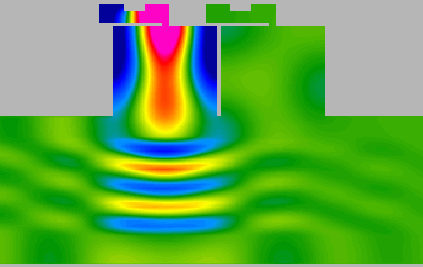This applicator and
system were
developed with intense use of the QuickWave™ modelling
software.
In particular, field pattern studies which would have simply been
impossible to conduct experimentally were necessary for the
optimisation.
A scenario with two
closely located 2450 MHz applicators (of a type called
“FERA”) is shown above. Dimensions are about
120×120×180 mm. In the microwave enclosure below
the applicators there is a 120 mm high load (in red), with 30 mm air
above and 40 mm below. The load permittivity is 6 and its
power penetration depth is 100 mm.
The movie shows the dominating magnetic field
directed
perpendicularly to the vertical cross section marked yellow, in that
central section. The intensity colour scale is: magenta = +100 %, green
= 0, dark blue = –100 %. In the power pattern image, dark
blue =
0 and the boundary dark/lighter blue = 10 %. The top image
shows
the momentaneous vertically directed standing electric field maxima and
the middle image shows the power deposition pattern.
There are two applicator modes: a dominating
evanescent
hybrid mode with index 2 in the shown cross section and 1 in the 180 mm
direction, and a compensating propagating TE10 mode having constant
electric field in the cross section plane, parallel to it. The magnetic
fields counteract at the applicator opening walls, resulting in a
“focused” propagating Poynting vector straight down
from
the centre of the applicator opening. Since the load height is
comparable to the power penetration depth, a standing wave pattern
results in it.
Another very important feature is also seen in the
movie to the left: there is very little energy coupling to the adjacent
un-energised applicator with waveguide feed. Under all normal loading
conditions, less than 1 % is cross-coupled between any adjacent
applicators. This contributes to a high system efficiency and protects
magnetron generators from damaging each other.
The FERA applicators
are very versatile and are currently employed in four
different projects. An example is shown here.



